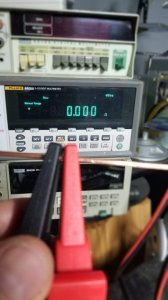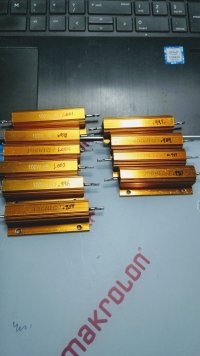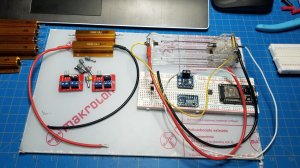completelycharged
Active member
- Joined
- Mar 7, 2018
- Messages
- 1,083
gauss163 : Would a cell with a 1kHz load have more cycle life than a purely DC load (assuming the same energy per cycle) ?

Wolf said:
completelycharged said:gauss163 : Would a cell with a 1kHz load have more cycle life than a purely DC load (assuming the same energy per cycle) ?
gauss163 said:There are onlya few cells listed with SOH between these extremes - two about83% and one at 77% SOH. Butthey have thesame AC IR as other cells near100% SOH so AC IR can't detect these significant SOH differences.
You are talking about Cell # 1210,1220, and 1245
Actually if you took the time to dig through my excel sheet you would see that out of 171 tested CGR18650CGs 3 of them "failed" with a "normal AC IR" Oddly enough the Liitokala and Opus didn't think the DC IR was that bad. So what gives?
Maybe a tester malfunction who knows but as far as statistics is concerned these 3 blips are noise. when you look at the whole picture
as in the pivot table it becomes a bit clearer or if you look at the whole 171count. Posted here for your viewing pleasure.
But likelythe DC IR will detect it.But I can't verify that since I can'tfind the DC IR values anywhere (and it seems the cell numbers are incorrect so I can't easily look them up).
The cell numbers are correct and you can look them up easily enough. Additionally the DC IR is posted there.A little mouse hover over the chartwill reveal the cell number and then you can filter the sheet with those numbers. Simple really if you know how to use excel.
If you are using it in google sheets forget about it download the sheet and open it in excel.
To get better intuitionit would help to have a wider distribution of SOH that includes more of these discrepancies.
Plenty of discrepancies in a sheet with over 6000 cells.............. LOL

daromer said:Because its true on its normal span of cycles/lifecycle. IR do not change much during a normal life. You will also see when digging deeper that most places never talk about what happens to a cell when you drastically extend the cycle life of a battery
BUT with that said and we all know that this is a generic saying based on tests and theories. I would say that Batterylife also do flatten alot of the information on how things work around batteries. The information on that site works well as long as you only rely on that information only.
If you start reading scientific papers around this and start to test it heavily you will see that they left out details
Something you need to consider to when reading paper is the result. How did they come up with the result? Many papers dont have a big enough test range for it to even be conclusive. Testing 10 cells give nothing of real life more than an indication.
daromer said:................... Especially if you like statistics and analysed data. Because you can with the numbers turn them in such a direction that they fit the goal of your report
bla bla blah.. Enough ramble from me
We are mostly laymen here not college professors looking for a sponsorship from some agency on how to test LI-ion batteries with outcomes skewedto somespecial interest group or manufacturer.
Wolf said:There are onlya few cells listed with SOH between these extremes - two about83% and one at 77% SOH. Butthey have thesame AC IR as other cells near100% SOH so AC IR can't detect these significant SOH differences.
You are talking about Cell # 1210,1220, and 1245
Actually if you took the time to dig through my excel sheet you would see that out of 171 tested CGR18650CGs 3 of them "failed" with a "normal AC IR" Oddly enough the Liitokala and Opus didn't think the DC IR was that bad. So what gives? [...]
Wolf said:So that brings me to my next point.When are we going to see your testing procedures, results and numbers [...]
Bubba said:I too found that most of the book is too vague https://www.scribd.com/document/36910556...le-devices
I don't think the author did their own tests. There is too much information missing to support the conclusions they arrive at. What did the waveforms look like? What equipment was used?
Is this based on 1 cell or the results of many?
What What occurred with the samples at 1kHz... they jumped.
My honest feeling is that if this information was accurate you would see more papers and data about using lower freq. to determine battery health by now. Published in 2013 the book is 7yrs old and there have been advances. On the surface the book looks good, but it brushes over things and doesn't seem to provide proper reference to the backing data. It's a book to make $ lacking engineering support and focus.
I did find the BIT-BMS which uses low freq. but the low freq is only used for SOC% and 1kHz is still used to determine if cells are good or not.


gauss163 said:The DC IR should reveal more, but there could also be other factors that come intoplay. Are all the cells from the same source?Areall cells used or are some used and some new-old-stock?
Everything is here you should be able to download it and at least get open office or some other free office suite to visualize the data.[size=x-small]gauss163[/size]
I need the link to the spreadsheet with the DC IR values, and alsothe link to the postedgraph with IR vs remaining capacity.
gauss163
I don't build powerwalls so I have no further data on that. But I have extensive knowledge of Li-ion batteries from prior (professional) work, so I may be able to helpin various ways.

completelycharged said:.................. What you are also starting to get an idea off is that the testing you are performing and carrying out is starting to get closer to the leading edge, hence the questions as to your "obvious" why has not somebody else done it already....
completelycharged
.............and the big question is can these cells be identified with the next gen Wolf tester ? ............






I know it has been a while since my electronics theory, can you get a PWM signal without harmonics. The sharper the on/off the higher the frequency the components to make it?completelycharged said:The PCA9685 is good for 24Hz - 1526Hz with 12 bit PWM accuracy so minimum pulse width of 160nS (1526Hz at 1bit PWM on state) so some interesting range, but nothing above 1.5kHz for now which may turn out to be ok as it avoids in the near term the wonders of harmonics and reactive power from places and wires you did not expect.
completelycharged said:[...] I'm wondering if there is some additional good info a cell gives out relating to the energy out vs volt drop vs time in those initial seconds for high loading [...]

